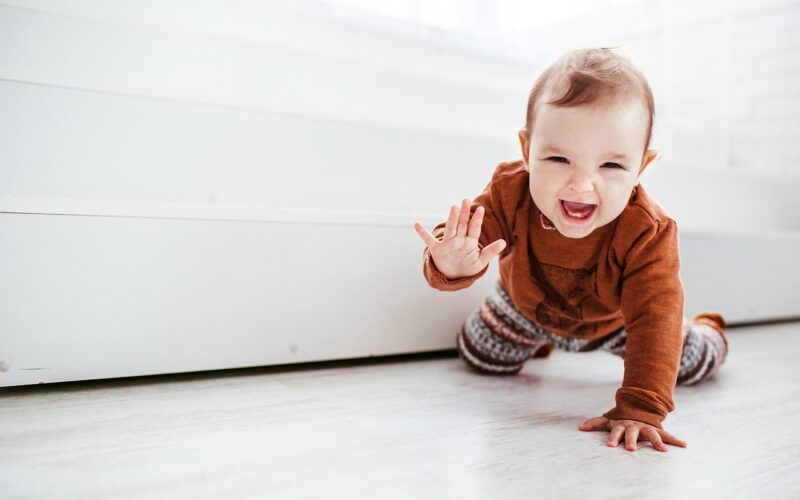There are many books on how to introduce your new baby to the dog family, and I am guessing you have read most of them.
You have probably played CDs to help introduce your pet dog to the sounds your baby is making so he can get accustomed to them.
Some mothers even bring home a blanket from the hospital, just so the dog can smell it before the baby arrives.
This would mean that all bases have been covered, but seven months after the birth of your baby, when he or she begins to crawl, you notice your dog is acting strangely. Why is that?
Your dog lives with your baby, but it didn’t expect your baby to begin to crawl. This new mobility can be very upsetting and even confusing to your pets.
Now that your child can crawl, he or she will move to areas that your dog once thought were his or his alone.
Also, now your child can easily approach your pet without waiting for it to come to him or her, which is strange.
If your baby and dog do not get along fine, you will see the signs from when your baby begins to crawl. There are a few questions you might want to consider;
First of all, does your dog approach you happily when you’re sitting on a couch and holding your child? Even if it does, does it stay out of arms’ reach, or does it snuggle in close to you and the baby?
Does your dog seem interested in your baby’s activities or nervous about baby things?
More management
Now that you know your dog and your baby are not best of buddies at the moment, it is the right time for you to pull out those baby gates you got and put them to use.
When your child is exploring all the nooks and crannies of your living room, ensure that he or she does so without the supervision of your dog.
The reason for this is that many dogs are protective of items that they considered theirs (their toys are and obvious example) your dog might even consider the corner where you kept it’s cushioned bed as its property as well so he may not find it funny when your child crawls around that area.
So until you are sure that your dog is comfortable with all of your child’s explorations, make sure that you keep the both of them separated from each other as much as possible.
Provide escape routes
A lot of dogs are usually just fine as long as the baby isn’t chasing them up and down. But you understand that as your child grows week by week, he or she gains speed while crawling and one of your baby’s primary interest at that point would be your dog.
Well, it is ok for a baby to pursue your dog as long as you provide enough escape routes for the animal.
Be sure that your baby cannot cage your dog into a corner. Without an escape route, your dog will be left with the fight or flight response to stress and trust me you’ll never want your dog to fight your baby back.
The application if gentle touch
A baby who just started crawling is not old enough to truly understand that there is need to be gentle when touching your dog or even you for that matter. But that doesn’t mean you shouldn’t make attempts to teach your baby to gently touch things including your dog.
If you notice that your dog is always happy to sit beside you and your child, move your baby’s hand and gently stroke your dog’s fur with his or her hand.
Always be careful to avoid your pet’s eyes and ears when stroking his forehead with your child’s hands it is best that children only pet dogs on their backs and sides also no matter how careful you think you are as a parent little children and naturally prone to having sticky fingers which makes it very easy for your baby to accidentally put on your pet’s fur because of how naturally grabby he or she is and the stickiness of the child’s hand can trap some of the furs.
Don’t make the mistake of forcing contact
You know that most of the time when your child begins to approach your pet, he or she is only trying to be friendly and even a dog can sense that a lot of times.
It is wonderful because dogs are a specie that can easily perceive and accommodate human behaviour but if you notice your dog is uncomfortable, the worst thing you can do in such situations is to hold it still and allow your baby to pet it but that is exactly what many parents end up doing.
The reason why some parents do that is because they feel that by holding their pets, they’re trying to make the dog understand that it is safe for them to make contact with the baby because the child is only trying to be friendly. However, in this case the dog would be learning the opposite of what you are trying to teach it.
The animal will feel that you are only forcing him to make contact with something it find scary and this will cause the dog to avoid your child as much as possible.
Set up fun interactions
If you are keen on making your dog like your kid, the easiest way to do that is have interesting things happen when the child is around.
That may sound very simple but most of the time people end up giving their children more attention and leaving the dog behind.
Then when the child is asleep they begin to pay some attention to the dog.
You wouldn’t blame any parents for passing more attention to their child, but there is a way you can strike a balance if you’re trying to build a relationship between the pet and the baby.
One of the things you can do is to teach your pet the name of some of its toys, then when you have your child around have your dog go and search for the toys and bring it back to you.
You could also give your dog a treat whenever you’re playing with your baby; this will help him associate that happy feeling with the presence of your child.
Very soon your baby will begin to easily fling food while eating and your dog will be super excited because it will have so much extra to eat. That is why they have to become best friends early enough.
It is very easy for children and dogs to get along just fine, but it is the duty of you as a parent to orchestrate that friendship.








